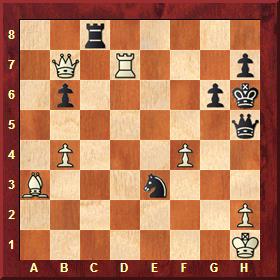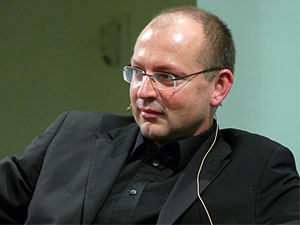Refuting the refutation
By Prof. Christian Hesse
The reverse also has a reverse – Japanese proverb
In his parable The garden of forking paths the writer Jorge Luis Borges
examines the relationship between past, present and future. What has gone before
is stored up as facts, the future is a developing and dynamic process in which
– in whatever manner – one of the logically possible continuations
is selected.
This is a metaphor which quite fits the development of a game of chess over
time. In chess it is the players who at each fork in the path take decisions
as to what course their journey will take. They make these decisions by following
with their imagination some of the possible ramifications to as great a depth
as they can, by constructing according to their experience an evaluation of
the position which will have been reached, and thus coming to a decision about
their next move based on calculation and intuition.
The choice of just about each move is the result of evaluations which take
some steps in time into the future of the actual position. Thus it is understandable
that a manœuvre can sometimes be refuted by another one which arose on
the basis of a more far-reaching vision of the future, and that the latter in
its turn can be refuted by even deeper analysis, etc.
Position 202 with all its apparent latent energy is an illustration of this
process of successive refutations by ever deeper mining operations. On seeing
this landscape on the board, one irresistibly thinks that the end is nigh –
but whose end?
N. N.–N. N., 1944

Black to move
Black acutely had to worry at once about the threatened mate on h7 and came
up with the multi-purpose move 1...Rc7!!. White spontaneously
resigned, since he had hallucinations about losing a rook. He spotted the sad
fact that taking the agent provocateur leads to mate: 2.Qxc7 Qf3+ 3.Kg1
Qg2# or, even worse, 2.Rxc7 Qd1#.
The subtle counter to the rook move by 2.b5!! with the threat
of 3.Bf8+ and mate did not occur to him. In analysis it was thought that Black
would then have nothing better than seeking salvation in a draw with 2...Qd1+!
3.Rxd1 Rxb7. But there are also holes in this drawing idea, because the riposte
2.b5 was in its turn parried with a deeper insight into the microstructure of
the position: instead of 2...Qd1+ Black can play for a win with the counter-parry
2...Qe2!!, because after 3.Bf8+ Kh5 4.Rxh7+ Kg4 White is mated
in four moves at most. An operation which appears to win the day for Black.
But once again there is a reversal of fate: White does not make use of 3.Bf8+,
but refutes Black’s winning attempt with the counter-offensive 3.Rxh7+!!
Kung Fu fighting!! If Black now continues with his intended 3...Rxh7, then after
4.Bf8+ Kh5 5.Qxh7+ Kg4 6.Qxg6+ Kf3 7.Qh5+ Ng4 8.Qd5+ Kxf4 9.Bd6+ he has had
it this time, because White wins the endgame. One flash of wit meets another!
But even then the last word has not yet been said: you see, Black’s
best reply to the rook check 3.Rxh7+!! is 3...Kxh7! 4.Qxc7+
and he finally takes flight with 4...Kg8 into a position where
he can expect a perpetual series of checks, because 4...Kh6 5.Bf8+ Kh5 6.Qh7+
Kg4 7.Qxg6+ Kf3 8.Qh5+ Ng4 9.Qd5+ Kxf4 10.Bd6+ would once more be favourable
for White. So, all in all, a draw!
Is that the heart of the matter? Or can further deep-mining operations come
up with something significantly different? The question remains open. But even
as such, the above position is a metaphor for genuine fighting chess, a wild,
good-going brawl with an open exchange of blows, in which every tempo demands
the greatest of precision in positions loaded with dangers for both sides and
where the analysis is marked by a series of delightful about-turns in the evaluation.
Replay the position and variations on our JavaScript board

[Event "Christian Hesse"] [Site "?"] [Date "1944.??.??"] [Round "?"] [White
"N.N."] [Black "N.N."] [Result "1/2-1/2"] [SetUp "1"] [FEN "2r5/1Q1R3p/1p4pk/7q/1P3P2/B3n3/7P/7K
b - - 0 1"] [PlyCount "7"] 1... Rc7 $3 2. b5 $3 {with the threat Bf8 mate.}
(2. Qxc7 Qf3+ 3. Kg1 Qg2#) (2. Rxc7 Qd1#) 2... Qe2 $3 (2... Qd1+ 3. Rxd1 Rxb7
$11) 3. Rxh7+ $3 (3. Bf8+ Kh5 4. Rxh7+ Kg4 {and White is mated in four moves
at the most.}) 3... Kxh7 $1 (3... Rxh7 4. Bf8+ Kh5 5. Qxh7+ Kg4 6. Qxg6+ Kf3
7. Qh5+ Ng4 8. Qd5+ Kxf4 9. Bd6+ { and White wins the endgame.}) 4. Qxc7+
Kg8 {and Black can expect a series of perpetual checks.} (4... Kh6 5. Bf8+
Kh5 6. Qh7+ Kg4 7. Qxg6+ Kf3 8. Qh5+ Ng4 9. Qd5+ Kxf4 10. Bd6+ {would once
more be favourable for White.}) 1/2-1/2
Christian Hesse holds a Ph.D. from Harvard University and
was on the faculty of the University of California at Berkeley until 1991. Since
then he is Professor of Mathematics at the University of Stuttgart (Germany).
Subsequently he has been a visiting researcher and invited lecturer at universities
around the world, ranging from the Australian National University, Canberra,
to the University of Concepcion, Chile. Recently he authored “Expeditionen
in die Schachwelt” (Expeditions into the world of chess, ISBN 3-935748-14-0),
a collection of about 100 essays that the Viennese newspaper Der Standard
called “one of the most intellectually scintillating and recommendable books
on chess ever written.”

Christian Hesse is married, has an eleven-year-old daughter and an eight-year-old
son. He lives in Mannheim and likes Voltaire's reply to the complaint: ”Life
is hard” – “Compared to what?”.
 The
Joys of Chess
The
Joys of Chess
This is an unforgettable intellectual expedition to the remotest corners of
the Royal Game. En route, intriguing thought experiments, strange insights and
hilarious jokes will offer vistas you have never seen before. The beauty, the
struggle, the culture, the fun, the art and the heroism of chess – you
will find them all in this sparkling book that will give you many hours of intense
joy.
Christian Hesse is a Harvard-trained professor of Mathematics who has taught
at the University of California, Berkeley (USA), and since 1991 at the University
of Stuttgart. He has written a textbook called 'Angewandte Wahrscheinlichkeitstheorie'.
Chess and literature are his main hobbies, and he also likes fitness and boxing.
His heroes are the ones who fall to the bottom and rise again, fall and rise
again…
From the foreword by World Champion Vishy Anand: "A rich
compendium of spectacular highlights and defining moments from chess history:
fantastic moves, beautiful combinations, historical blunders, captivating stories,
and all this embedded into a plentitude of quick-witted ideas and contemplations
as food for thought."





















 The
Joys of Chess
The
Joys of Chess




